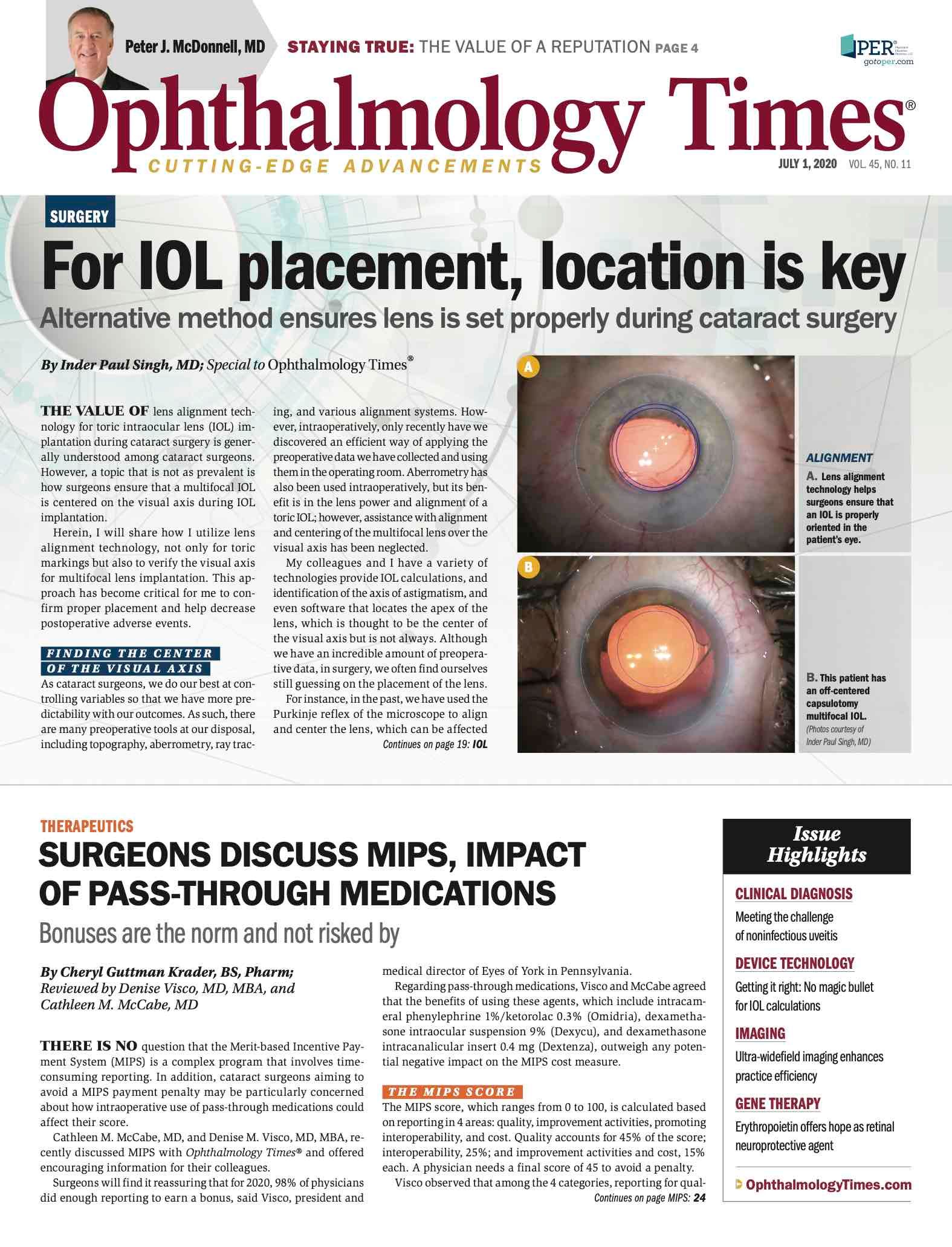Publication
Article
Digital Edition
Optimizing practice environment, outcomes, and patient satisfaction
Author(s):
Physicians must play a critical role in setting the tone in an ophthalmology facility

This article was reviewed by Suber S. Huang, MD, MBA
“You make the weather. Own your outcome. Create the culture.” These are 3 big tasks that Suber S. Huang, MD, MBA, assigned that were perhaps previously unrecognized by ophthalmologists.
There are 3 important ingredients in this recipe, according to Huang, president and CEO, Retina Center of Ohio, voluntary assistant clinical professor, University of Miami, Bascom Palmer Eye Institute.
“The physician has a critical role in developing and leading the professional culture of the organization,” he said. “Collaborative partnering approaches between the physician team and the patient are important in fostering efficient and effective care, and patient satisfaction and retention of patients is the most important metric for financial success and the cornerstone of organizational sustainability.”
Related: Setting up shop: Three common real estate errors physicians make
Climate change
Upon entering the office, physician leaders, administrative leaders, and technician leaders must thoroughly believe in what they are doing. These individuals set the tone in the office, which is a major factor in making the office operate more efficiently.
“There is no substitute for leadership, organization, discipline, and the professional will to follow through on a desired plan of action,” Huang said.
If a physician is trying to implement a new office system that will result in more efficiency and productivity and be more helpful to people, that plan must be believable to every person in the office, and the physician must partner with his or her patients, according to Huang.
Lean and mean
Huang advised physicians to determine what the real goal is from greater office efficiency, such as adopting a lean strategy. Are the goals increased income and/or time savings?
But, importantly, what are the effects on each physician, patients, and staff members. “Faster” and “more” are not necessarily better.
According to Huang, physicians must understand that their missions, that which they divined in their heads, is not necessarily everyone’s mission.
“They need to articulate exactly the physician’s vision, the mission, and the best possible outcome,” he said.
Related: Navigating office management during crisis no easy task
Asking everyone from the new technician to the senior partner to describe the perfect day should reflect the same vision as the physician so that the avenue to the goal is clear.
Although that perfect outcome may not be readily attainable, redirection can be undertaken, he emphasized. Huang also advised that doing it right the first time is the best route. Time is wasted when a mistake is made and the situation is revisited.
“For example, if endophthalmitis develops in a patient, but the physician performed the surgery 15% faster, he or she is going backward,” he said.
Being lean does not work in a vacuum. Huang explained that everyone in the office is involved in creating an efficient environment.
“The sobering statistic is that 65% to 92% of lean programs fail,” he pointed out.
The reasons for the failures include the following: lack of management support and no idea how to actuate support; incorrect strategy deployment, with the focus on saving seconds versus achieving a better outcome and greater satisfaction for patients; choosing an incorrect project to achieve more efficiency within an individualized environment and not attempting to emulate the unattainable; inappropriate team members, including those who are simply unable to embrace the system; incorrect scope, such as a project that may be too all-encompassing considering all the individuals involved in a large practice; incorrect measurement system; and incorrect implementation.
Related: Returning to the new 'norm' of ophthalmic practice
Huang highlighted 2 important trends of economic forecasting. The first, the broken-arrow era, is defined as the time when physicians are about to be overrun and slaughtered and financial austerity is important.
“The current financial system is in the broken-arrow era,” he said. “Of all the factors that play into the total cost of health care, the rate and unit cost of injections is the fastest-growing health care cost, and it isappropriate to look at.”
The second trend is the concept that as more is learned about how to care for patients, the recognition is that medicine is less art and more protocol, a trend that merits attention, Huang pointed out.
“The trend is between consumer-driven and patient-driven and between physician/patient teaming,” he said. “The patient has to appreciate what the physician is doing, for example, keeping appointment times and delivering perfect health care.”
Related: Five-step leadership system supports patient workflow, staff efficiency
Creating the culture
“The physician has to create a culture that everyone can live with,” Huang said. Patient satisfaction seems to be the key, and many factors drive the patient experience in a practice. A few deserve special attention.
One, as noted in the Accenture Global Customer Satisfaction Report 2008, is that price is not the main reason for customer churn, but rather overall poor quality of customer service.
“A physician may perform examinations faster, but if he or she is perceived as rushing patients through a production line, that patient will not be happy,” he said.
A second observation by Bain & Company, an American management consultancy headquartered in Boston, Massachusetts, is that a customer is 4 times more likely to move to a competitor in the face of a service-related and not a price- or product-related problem.
A related observation by Marketing Metrics is that the probability of selling to an existing customer is 60% to 70% but selling to a new prospect is 5% to 20%.
“This means that your patients are incredibly valuable to your practice,” Huang said. “Physicians must keep their patients happy, and must understand what they fear, what they have, and what they will appreciate.”
Related: Small practices can success with a patient-first focus
Lee Resource reported that for every customer complaint, there are 26 other unhappy customers who have remained silent.
“Physicians must pay attention to even a single complaint,” Huang noted.
In line with this, 1st Financial Training Services reported that 96% of unhappy customers do not complain; however, 91% of those will simply leave and never return. In support of this, the White House Office of Consumer Affairs found that a customer who is dissatisfied will relate their dissatisfaction to 9 to 15 patients; about 13% of dissatisfied customers tell more than 20 people.
“It makes sense to keep patients happy. As the practices are becoming more efficient, they should not trade off decades of good will,” he said.
The White House Office of Consumer Affairs also reported another interesting statistic, namely, that patients who have their issue resolved will relate that to 4 to 6 people; 70% of buying experiences are based on how the customer feels they are being treated, according to McKinsey.
The ideal scenario is avoidance of negative experience, because 12 subsequent positive experiences are needed to make up for that 1 bad experience.1 Emmet Murphy and Mark Murphy pointed out that a 2% increase in customers has the same effect as decreasing cost by 10%, which is a profound effect on the bottom line.2
“There is almost nothing we can do to increase our bottom line by 10%; making sure our patients are happy accomplishes that,” Huang pointed out.
Related: Productivity may be key factor for a successful practice
To foster an environment for success, Huang also advised creating a can-do culture. This can lead to success in the office.
“All technicians and staff should feel that they have a part in improving the process and the experience in the office,” Huang explained. “Everyone’s experience should be better. If they are happy, everything flows better.”
In addition, he urges physicians to encourage innovation and discovery by patients and staff and promote physician/patient teaming.
Read more by Lynda Charters
Suber S. Huang, MD, MBA
e:DrHuang.RCO@gmail.com
Dr. Huang has no financial interest in any aspect of this report.
---
REFERENCE
Murphy EC, Murphy MA. Leading on the Edge of Chaos: The 10 Critical Elements for Success in Volatile Times. Prentice Hall Press; 2002.

Newsletter
Don’t miss out—get Ophthalmology Times updates on the latest clinical advancements and expert interviews, straight to your inbox.




